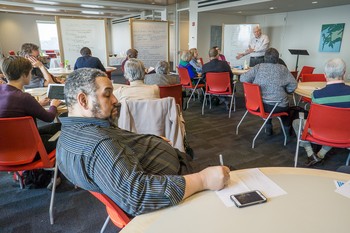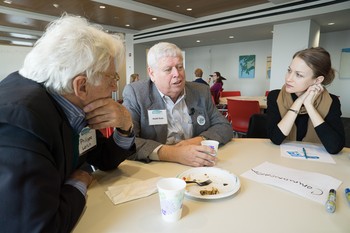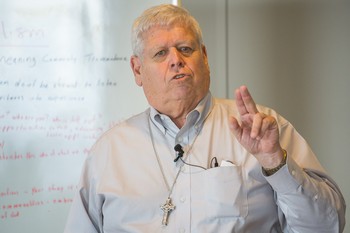Thirty participants joined Heath Rada, moderator of the 221st General Assembly (2014) of the Presbyterian Church (U.S.A.), at Auburn Theological Seminary in New York City for discussion and input on the future of the denomination. New York was Rada’s third stop on a five-city conversation tour. Two previous meeting took place in Atlanta. Upcoming meetings are scheduled March 12 in San Diego, Calif., and March 19 in Ames, Iowa.
The conversations are follow-up to Rada’s “Call to the Church” issued last summer and are meant to complement information collected by a Committee on the Office of the General Assembly (COGA) survey. Results of these conversations, along with other data collected, will be forwarded to “The Way Forward” committee of the 222nd General Assembly (2016) of the PC(USA) meeting this summer in Portland, Ore.
“My goal today is to go away with a list of five or six ideas of what the people here want the church to be,” Rada said. “I don’t have an idea what that is; that’s why you’re here.”
He noted that the conversations in Atlanta—first with conservative-leaning representatives of The Fellowship Community and then with African-American church leaders at Johnson C. Smith Theological Seminary—had similar content. Rada said, “Both groups came willing to ask the question, ‘Let’s see how we can love each other to be the church?’”

Participants offer feedback during a churchwide listening session with Heath Radaat Auburn Theological Seminary in New York City. —Gregg Brekke
The moderator had three discussion starters for the group, asking: How can the PC(USA) highlight its history in education? What are the denomination’s financial priorities? And what is the most effective organizational structure for national offices?
Following suggestions that the Presbyterian Mission Agency and Office of the General Assembly merge as quickly as possible, Rada responded, saying, “My bias is, if we do that at this assembly, it is putting the proverbial cart before the horse. Until we’ve decided where we want the church to go and put a structure around it, it’s hard to know what combining these agencies would look like.”
“We need to give ourselves permission to make mistakes and take risks,” he said, offering the possibility that entrepreneurial exercises may be needed as the General Assembly formulates a new structure. “We don’t have time to sit back for six or eight years to see what will be decided.”
Before hearing input from the group, Rada said, “My general guess is that there’s a lot of similar sentiment going around the church, and I believe that you’ll be voicing some of these same ideas.”
A sampling of ideas from attendees included:
- How does a largely white denomination bridge the racially pluralistic future of the nation?
- How do we open our church to those who’ve been shut out—such as young people and persons from racial-ethnic groups?
- How do we react immediately to social issues such as police and gun violence?
- We know what Christian education means within our four walls, but what do we do when we’re outside the church?
- How do we better understand what it means to be a connectional church?
- In the wake of Black Lives Matter, can we be leaders in moving the conversation forward?
- How can we focus more on creation justice?

Philippe Lerch, from First Presbyterian Church in the City of New York, Heath Rada and the Rev. Erin Keys, pastor of First Presbyterian Church in Greenwich, Conn., talk about communications during a churchwide listening session at Auburn Theological Seminary in New York City. —Gregg Brekke
After generating ideas, the group broke into teams to discuss the themes of local ministry, social witness, evangelism, communication and structure. After hearing the results from each group, Rada responded, “It’s fascinating—now that I’ve done three of these conversations—to see how many similarities there are.”
In his closing remarks, Rada said that, in spite of challenges, he continues to be hopeful for the denomination, citing the three reasons he hears why young people are returning to PC(USA) congregations: The PC(USA) is a safe place to ask questions; it’s a denomination where justice and service are highlighted; and it is a faith community where diversity is accepted.
Results of the discussions will be collated into a standardized format so top priorities can be presented to “The Way Forward” committee of the General Assembly. The results will include information collected at the five discussions attended by Rada and from the 10 other groups conducting the discussion facilitated by a video message from the moderator.

